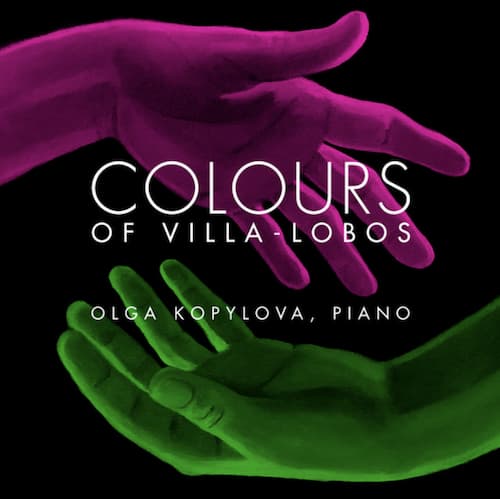“Ms. Kopylova approaches the repertoire with an authority that is welcoming.”

Olga Kopylova
The pianist for the São Paulo Symphony Orchestra, Olga Kopylova, has created an album of selections from the extensive repertoire for solo piano written by Brazilian composer Heitor Villa-Lobos. Ms. Kopylova first encountered Villa-Lobos’ music while a student at the Moscow Conservatory. At first reluctant to enter into Villa-Lobos’ complex world, she began to explore the composer’s repertoire when she joined the São Paulo Symphony Orchestra in 2000.
This recording, The Colours of Villa Lobos, released on the Azul Music label (AMDA1751), brings out Villa-Lobos’ music from 1918 (Suîte Floral) through the 1940s (Bachianas brasileiras No. 4).
This is complex music that is full of syncopations: a work such as the Chôros No. 5 from 1925 starts with a simple ABA structure but one of the rhythmic tricks of the work involves rhythmic delay: we start with a quadruple-meter left-hand with syncopated chords and then overlay a melody in triplets that has its own syncopation. It’s like listening to music on two different sides of the room at once. In the middle a new melody is introduced, based on the sentimental song style of the modinha. When the opening section returns at the end, yet another syncopated pattern is overlaid in a third voice. There’s a reason this work has the nickname ‘Alma brasileira’ (Brazilian Soul).
Heitor Villa-Lobos: Chôros No. 5

Azul Music label
Even in his earliest work, Suîte floral from 1918, we find this same use of complex rhythm with each voice seeming to go its own way. Yet, the result is something that takes you into a different world of early 20th century pianism. Villa-Lobos doesn’t need to create piano music that takes, say Franz Liszt to South America, he shows that there’s something different happening there. It also doesn’t sound like the experimental piano music coming out of France at the same time – it’s quieter and yet, in so many ways, so innovative.
Ms. Kopylova includes three multi-part works: Suîte flora (3 movements), Circlo Braileiro (4 movements), and closes with Carnaval das crianças (8 movements). These enable us to see how Villa-Lobos develops an idea across several works.
The Carnaval das crianças (Children’s Carnival) bases its movement on familiar children’s story characters such as Pierrot, Pierrette, and Little Red Riding Hood, and on children’s dress-up characters, such as a little devil, a little jester, and the like. The first movement, O ginete de Pierrozinho (Little Pierrot’s Horse), is definitely a horse, but a horse in the hands of a child, galloping here and there in constant motion.
Heitor Villa-Lobos: Carnaval das Crianças, No. 1 – O Ginete do Pierrozinho

© Luis Crispino
The last movement of this cycle, A Folia de um bloco infantil (The Frolics of a Band of Children), seems to summarize the various children’s antics. They’re no longer as active as they were in the first movement, but seem to be marching around, proud of the day’s work.
Valsa da dor, a work from 1932, is a dark work that dances in the shadows. You could imagine it as someone who dances with themself, the work seems so isolated and caught up in its own dreams.
Heitor Villa-Lobos: Valsa da dor
What is also an important part of this repertoire is the complexity of the work. We discussed the multiple cross-rhythms above, and all of that is just part of the technical challenges a performer faces. At times, everything seems to be dancing, with overlapping rhythms and harmonies that provide a multiplicity of sound worlds and colours.
After the 20 tracks on the recording, you have the feeling that you’re just approaching the smallest percentage of Villa-Lobos’ piano music. Ms. Kopylova approaches the repertoire with an authority that is welcoming. The music sings, it dances, it paints colourful pictures, and, as all good things, leaves you wanting more.
For more of the best in classical music, sign up to our E-Newsletter


